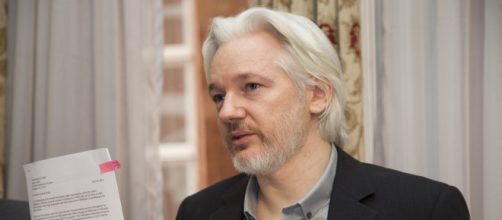Andrei Molodkin, the Russian dissident artist, has collected 16 works of art by donation, which he estimates to be worth around $45 million. These precious works of art by Andy Warhol, Rembrandt and Picasso, to name just a few, are locked away in a safe with a corrosive substance and might be destroyed. Why? Molodkin wants Julian Assange set free, and this is his protest. He believes Assange changed the history of journalism. He is concerned that repressing him means less freedom of speech.
The artworks are being placed in plywood crates alongside what is called the “dead man’s switch,” a pneumatic pump connecting two barrels, one with an accelerator and the other with acid powder, that could cause a chemical reaction that could, if strong enough, turn the safe’s contents to debris within two hours.
Each day, a 24-hour countdown begins that is only reset when Assange’s well-being is reported by someone close to him.
Assange has been held on remand in Belmarsh prison for five years and is due to face a court hearing on 20/21 February, which will most likely be his final bid to appeal against the US order to extradite him.
Collective artwork
Molodkin, who works with such materials as steel and ballpoint pen, crude oil, and human blood, spent around six months persuading collectors and artists to donate works to this project. He referred to them as a collective artwork, and they are all participating in it. He says they wish to open a dialogue with the White House and that solutions are to be found on the cultural platform.
There are also works by Jannis Kounellis, Andres Serrano, Robert Rauschenberg, Jasper Johns, Sarah Lucas, Jake Chapman, Santiago Sierra and Molodkin himself.
Assange’s wife, Stella, told the New Yorker that Molodkin’s project “is like a protective step … it’s a kind of human shield but in art. An art shield.” Whatever that means.
Molodkin says the works of art will only be returned to their owners if Assange is set free. One presumes they are happy with that arrangement.
In the Guardian last week, journalist Jonathan Jones expressed frustration with Molodkin’s plans by pointing out that it is a weak argument that will achieve nothing. He referred to it as a "banal stunt." He’s right. Molodkin and his followers are wrong to destroy valuable artworks in support of Assange’s misdoings.
Sure, they see him as a Libertarian renegade who needs to be set free. However, the value of those artworks and others that have been attacked over the years far outweighs the protester’s arguments.
Protest
This protest is just another long line of rather tiresome activism that’s become popular recently. Throwing paint or whatever protesters can find in their kitchen cupboards at famous artworks on display in galleries around the world, and then reading out statements decrying climate change or whatever is the current gripe on their social media. It gets them in the news for about five minutes, and if they can spread footage of the "event" on TikTok, maybe a few likes. Hey, it might even go "viral." Far out!
Molodkin has clearly taken this up a notch. Actually, destroying the works of art will eventuate some media coverage that may stay around for a few days.
However, it all depends on the public’s view of Assange’s cause. Sure, there’s been some protests in the UK, but there appears to be little interest elsewhere. I’m not surprised. Although the Australian government is still requesting Assange be sent back home and not to the US, they’ve been requesting this move for some time now, and the Americans appear to be dragging their feet.
Assange needs to face an American court of law and explain the actions of Wikileaks in publishing US Army intelligence analyst Chelsea Manning’s illegally obtained footage, which she handed over to Assange.
If Assange was the brilliant journalist his supporters say he is, he would have discovered that he was sitting on a goldmine once he checked out the footage.
The footage was clearly something the Army would not want the public to see. If Assange had approached them and asked how it had all come about and dug into the reaction from the State Department, there would have been days, if not weeks, of stories that followed.
Of course, it would have taken some good investigative journalism to ensure you weren’t immediately imprisoned. Instead, you worked your way through the tangled mess of the footage and spoke to all the departments responsible for the shootings and right up to the heads of the departments.
You’d have heaps of copy that could be syndicated to media worldwide.
Assange would have been hailed as a groundbreaking journalist who asked questions and got answers. Instead, he produced small-time gutter journalism and was hounded into hiding. Julian Assange broke the golden rule of journalism, never becoming part of the story.


